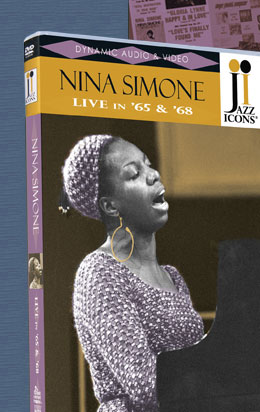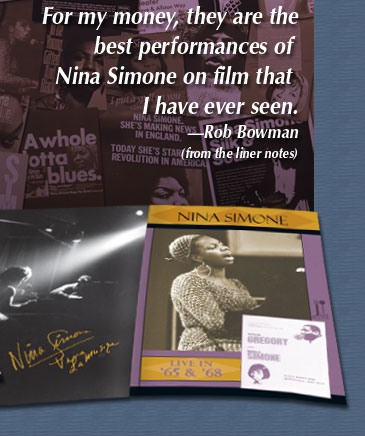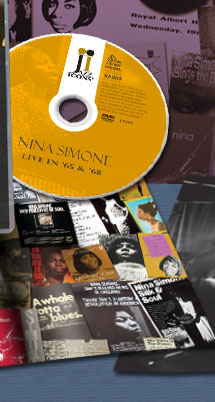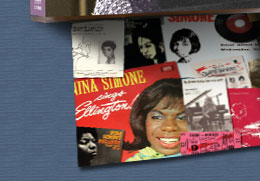




 |
 |
|
|||
|
|
|
||||
|
|
|
||||
|
|
|
||||
|
|
|
||||
 |
|
||||
 |
|
||||
 |
|
||||
|
|
|
|
|
|
|
| Jazz Icons: Nina Simone features two incredible concerts from 1965 and 1968 showcasing the multifaceted diva in all her glory. Simone shines as a jazz vocalist extraordinaire on “Tomorrow Is My Turn,” as a definitive folk interpreter on Bob Dylan’s “The Ballad Of Hollis Brown” and as a passionate civil rights activist on both the epic “Four Women” and the scorching “Mississippi Goddam.” This DVD is a must for Nina Simone fans as she displays all of the qualities that made her both a supremely gifted jazz singer and pianist as well as the “High Priestess of Soul.” | |
 |
|
|
|
 |
|
|
|
24-page booklet Liner Notes by Rob Bowman Foreword by Lisa "Simone" Kelly Cover photo by David Redfern Booklet photos by Lee Tanner, Giles Petard, Susanne Schapowalow, Val Wilmer Memorabilia collage Total time: 64 minutes |
|
|
Sample of Foreword: Nina Simone. Those two words bring to mind other words: musical genius, perfect pitch, classical training, Civil Rights activist, revolutionary, Titan, and Queen, just to name a few. I’m the only person in the world who called her, Mommy. To say the least, Nina Simone is more famous now than she was when she was alive… isn’t that ironic? As her daughter, I still have a hard time with that one. —Lisa "Simone" Kelly
Sample Liner Notes by Rob Bowman: Nina Simone was one of the great iconoclasts of American music. Born poor and black in the southern United States, she had a lifelong love of J.S. Bach. Raised in the church playing gospel and steeped in the blues, for the first many years of her career, her repertoire was heavily rooted in Tin Pan Alley standards. Filed in most record stores under the heading jazz, she detested the term, feeling it was a racist way of classifying black performers. A diva to the nth degree, renowned for reducing promoters, record company personnel and journalists to tears, she had a playful and ingratiating sense of humor. Perhaps best known for the scathing protest songs she wrote and performed between 1963 and 1970, outside of those years, she rarely performed this material. An individualist of the highest order, Dr. Nina Simone was capable of doing just about anything once she took the stage. Fortunately, a number of her performances during the 1960s were filmed for broadcast on European television. The DVD you presently hold in your hands contains two of the best of those performances: one from December 1965 and the other from September 1968. ... In September 1968, England’s Granada TV broadcast the second concert featured on this DVD. This time, Simone had a new band including her younger brother, Sam Waymon, on organ, tambourine and background vocals. The version of “Backlash Blues” shot by Granada dispenses with the harmonica and guitar fills heard on the LP version and instead brings Simone’s piano to the fore and adds a serious dollop of funk to the stately rhythm. The physicality of Simone’s performance is a joy to watch, her body undulating as she lays out a bass line that is slightly reminiscent of Albert King’s “Born Under A Bad Sign” juxtaposed with funked-up right hand piano chords. After her spartan piano solo and a brief groove section featuring piano and drums, Simone sings a new verse (that is also heard in a live version issued by RCA on the ‘Nuff Said! LP recorded five months earlier) about how Langston Hughes always encouraged her to “keep on working until they open up the door” at which point she was to tell her audiences exactly where it was at. Living up to Hughes’ admonition, the performance ends with Simone leaping up from the piano in rapturous catharsis. The 1968 concert opens with “Go To Hell,” a jazzy blues song included on Simone’s second RCA LP, Silk And Soul, issued in the fall of 1967, which segues immediately into Simone’s cover of “Ain’t Got No/I Got Life” from the Broadway musical Hair. The former was written by Morris Bailey, brother of jazz organist Jimmy Smith’s drummer Donald Bailey and a pianist in his own right, and in this performance features a brilliant coda. Within a few weeks of this concert, “Ain’t Got No/I Got Life” would be a #2 hit for Simone in the U.K. A few months later it stalled at #94 on Billboard’s U.S. pop chart. In Simone’s hands, what had been a corny piece of fluff on the Hair soundtrack became a soulful assertion of the will to overcome poverty and destitution. If proof were ever needed that meaning in music is ultimately determined in performance, Simone’s version of “Ain’t Got No/I Got Life” would suffice. Her brother, Sam Waymon, doubles her vocals for the triumphant chorus of “I Got Life” at the end of the song. ...
All words and artwork on this page ©Reelin' In The Years Productions. Unauthorized use is prohibited.
|
|
Site contents ©Copyright 2008 Reelin' In The Years Productions
Site designed by Tom Gulotta